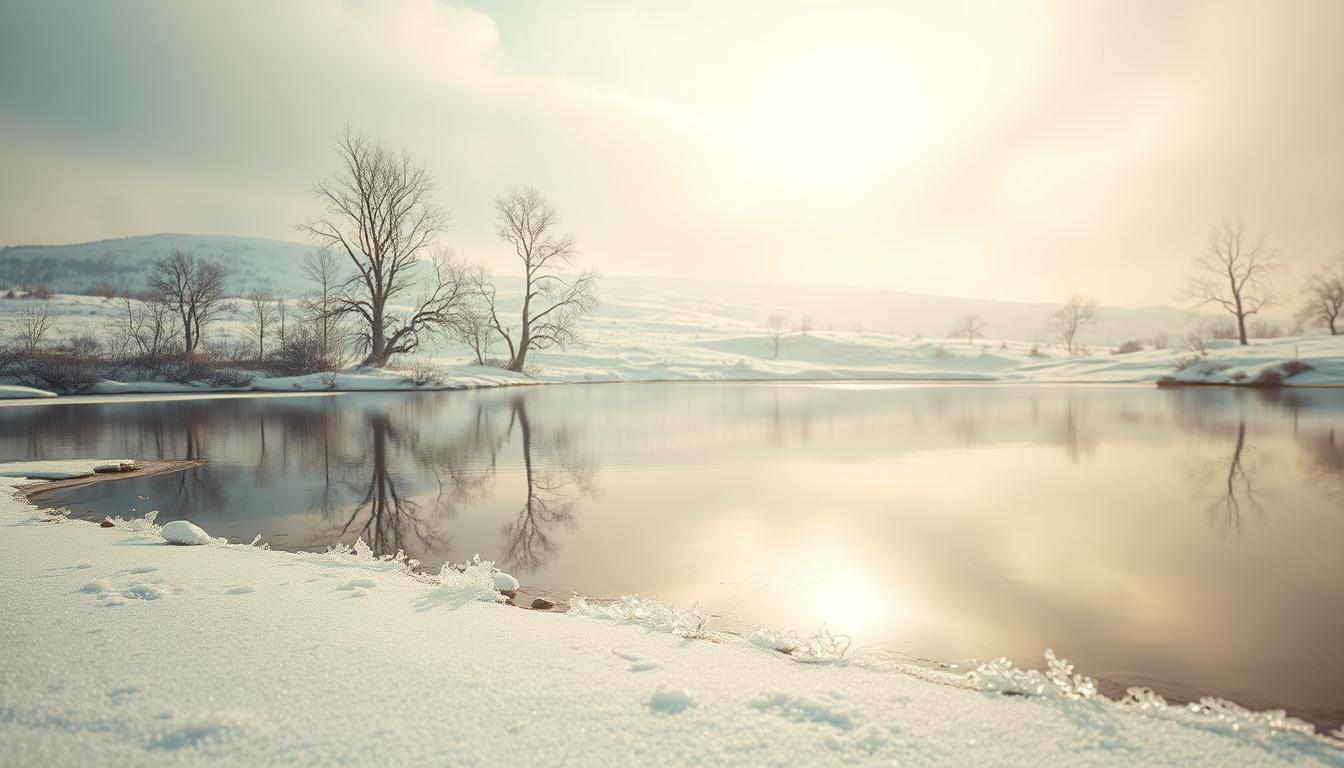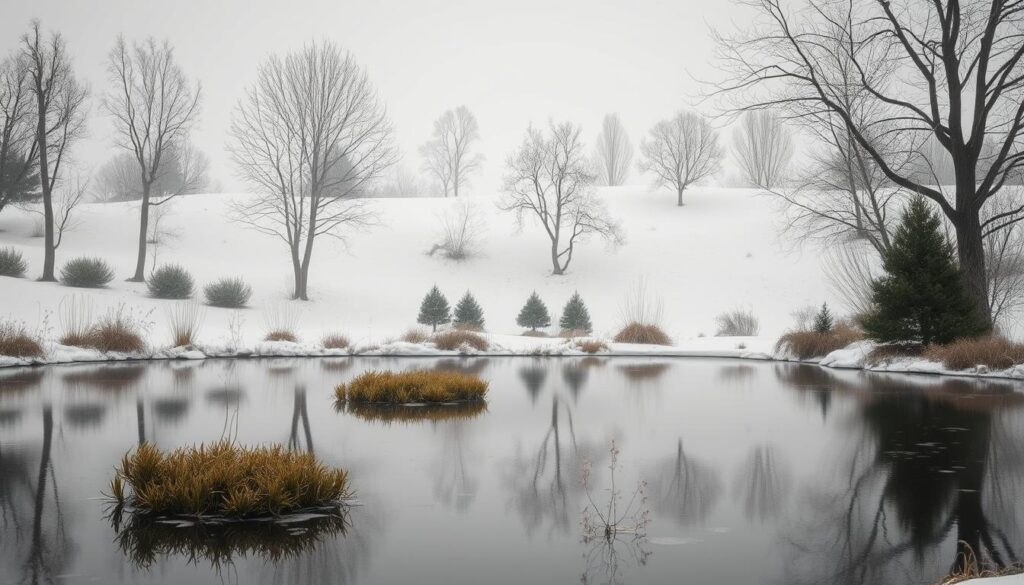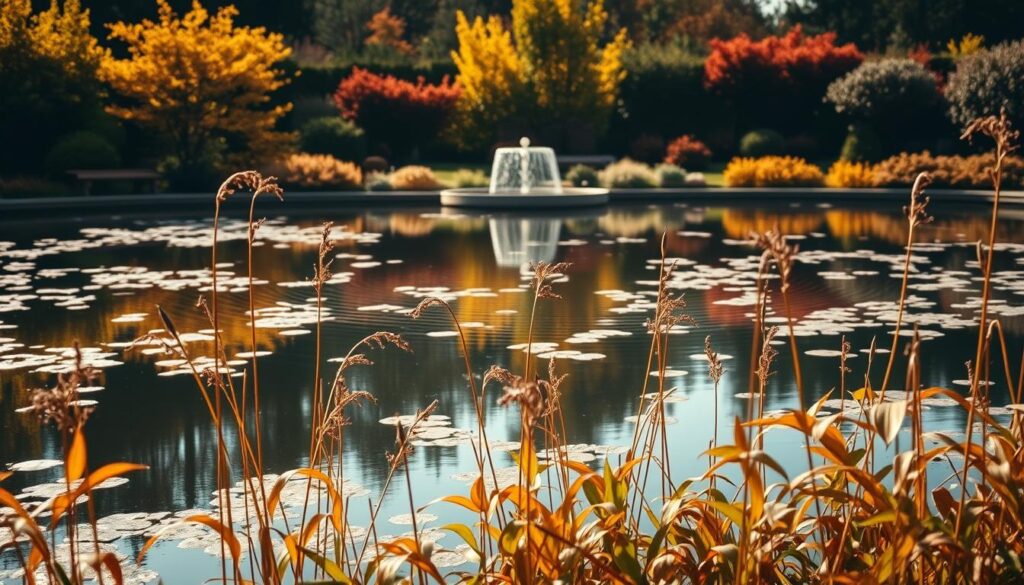
Keep your water feature healthy through each season by planning maintenance now. Debris builds up over the year and decaying organics reduce oxygen and release harmful gases. Timely fall tasks protect fish and cut spring cleanup.
A resilient system depends on filtration, circulation, aeration, de-icing, and smart planting. Shut down and store above-grade plumbing and clean filters and UV units before freezing weather. Store pumps wet in a bucket of water to protect seals and make spring restarts easier.
Install aeration and a floating de-icer to keep a gas-exchange opening in ice and move diffusers to a shallow shelf so deep water stays stable for fish. Transition fish to wheatgerm food as temperatures drop and use cold-weather bacteria until water cools below critical levels.
Key Takeaways
- Remove debris in fall to prevent oxygen loss and toxic gas buildup.
- Shut down and store equipment properly to avoid freeze damage.
- Use aeration and a de-icer to maintain safe gas exchange in ice.
- Adjust feeding and add cold-weather bacteria as temperatures fall.
- Plan seasonal circulation to protect thermal layers and fish health.
Plan a Four-Season Pond Landscape That Performs in Winter and Thrives in Spring
Choose a site that limits leaf fall and balances sun and wind. Pick an area where nearby trees won’t dump heavy leaves into the water and where a windbreak reduces surface turbulence.

Design depth with a clear bottom refuge. A deep zone gives fish stable pond water to rest in and buffers day-to-night temperature swings. Mark shelves for marginals and lilies so you can lower pots before freeze.
Pick liners and plan for seasonal changes. Rigid plastic liners can crack from expansion; many owners drain before hard ice. Flexible liners tolerate movement and let you focus on circulation instead of full draining.
- Install a T-valve bypass to route water below the surface in cold weather.
- Reduce turnover from about every 2 hours to roughly once every 10 hours to retain heat and oxygen.
- Use netting and accessible maintenance points to catch leaves and limit organic buildup.
These steps create a resilient system that eases chores in cold months and speeds recovery in spring.
How to Build and Care for a winter garden pond That Shines Year-Round
Begin seasonal care with a focused fall cleanup. Net out leaves and collect debris right after trees drop foliage. Store netting indoors once cleaned to extend its life.

Manage water levels and skimmers
Lower water below the skimmer opening using a submersible pump, then drain skimmer and waterfall boxes. This prevents freeze-thaw cracking and saves repair time in spring.
Pumps, filters, and UV
Disconnect pumps and check valves; allow plumbing to drain. Rinse filter pads and bio media, clean UV quartz sleeves with white vinegar, and replace UV bulbs each season.
Plants and biology
Trim hardy plants, remove dead foliage, and move potted plants to the bottom pond for protection. Remove tropicals or bring floaters indoors.
Final steps: Vacuum fine silt, store equipment in a frost-free space (keep pumps submerged in a bucket of water unless the maker says otherwise), install aeration on a shallow shelf, add a floating de-icer, and switch fish food to wheatgerm. Dose cold-weather bacteria until pond water drops near 40°F and document your shut-down steps for next times.
Winter operations: oxygen, ice management, fish health, and water quality
Keep a small open spot on the surface so gases can escape and oxygen can enter without disturbing the deeper refuge where fish rest. A shallow aeration kit combined with a floating de-icer keeps that hole steady while avoiding churn that cools the bottom.
Aeration kit and de-icer
Place stones on a shallow shelf rather than the deepest bottom to avoid chilling the refuge. Use a floating de-icer or a low-wattage heater to hold a hole; do not bang or drill the ice, which stresses fish.
Feeding and temperatures
As water cools, switch to low-protein wheatgerm food. Reduce portions and frequency near 50°F and stop feeding when temperatures drop to about 40–50°F to prevent undigested food from fouling the system.
Circulation without stress
Turn waterfalls down or use a submerged bypass to minimize air contact. Target a gentle winter turnover—roughly once every 10 hours—to keep oxygen without stripping heat.
Small-pond vigilance and overwintering choices
Test water after heavy precipitation; acid pulses can drop pH. Add measured baking soda to buffer when needed.
Decide whether to keep stock outdoors or move them inside based on depth and local conditions. If you transport fish, use pond water and equalize temperature for at least two hours before transfer.
- Check pumps and lines regularly to ensure returns stay below the surface.
- Use predator netting if fish remain outside; sluggish fish are vulnerable.
Conclusion
Tie fall chores to spring goals by removing organics, protecting gear, and steadying circulation.
Keep the plan simple: net leaves and debris, drain skimmers and waterfalls, clean media and UV sleeves, and store pumps wet per maker instructions. Set shallow aeration and a floating de-icer and use a submerged bypass to cut turnover to about once every 10 hours.
Spot-check small ponds after heavy weather and buffer pH as needed. Reduce wheatgerm feeding near 50°F and stop around 40–50°F. If you must move fish indoors, transport them in pond water and acclimate temperatures slowly.
Practice a quick seasonal checklist each year to protect fish, extend pump life, and enjoy clearer water by the time spring arrives.








